虚拟现实在培训方面的应用
虚拟现实技术在教育培训中的应用现状与未来趋势分析

虚拟现实技术在教育培训中的应用现状与未来趋势分析引言在当今快速发展的科技时代,虚拟现实技术成为了一个炙手可热的话题。
虚拟现实技术通过模拟现实环境,使用户沉浸其中,提供了前所未有的体验。
在教育培训领域,虚拟现实技术也逐渐得到了应用。
本文将探讨虚拟现实技术在教育培训中的应用现状,并对未来的发展趋势进行分析。
一、虚拟现实技术在教育培训中的应用现状1.1 虚拟实验室传统的实验教学需要大量的设备和实验室场地,而且由于安全和经济等因素,学生的实际操作时间有限。
虚拟实验室利用虚拟现实技术,可以模拟各种实验环境,使学生能够在虚拟环境中进行实验,在操作过程中得到与真实实验相似的体验。
虚拟实验室可以提供更多的操作时间和更灵活的实验设计,可以大大提升学生的实践能力。
1.2 虚拟场景教学虚拟场景教学是通过虚拟现实技术,将学生带入虚拟的场景中进行学习。
例如,在语言学习中,学生可以通过虚拟场景来模拟日常生活场景,提高语言运用能力。
在历史学习中,学生可以通过虚拟场景体验历史事件,加深对历史知识的理解。
虚拟场景教学可以提供更加真实和生动的学习方式,使学生更加主动地参与学习。
1.3 虚拟导览与实践虚拟导览和实践基于虚拟现实技术,可以将学生带入到远离的地方,如博物馆、考古遗址等。
学生可以通过虚拟导览和实践感受不同地域的文化、历史和自然风光。
这种方式可以打破时空的限制,使学生能够更加直观地了解世界各地的知识,提高跨文化交流的能力。
二、虚拟现实技术在教育培训中的未来趋势2.1 个性化学习虚拟现实技术可以根据学生的学习需求和特点,提供个性化的学习体验。
通过内置的智能算法,系统可以根据学生的反馈数据和学习历史,自动调整内容和难度,以提供更加适合学生的学习资源。
个性化学习可以更好地满足学生的需求和提高学习效果。
2.2 协同学习与远程教育虚拟现实技术可以连接不同地点的学生和教师,使他们能够进行协同学习和远程教育。
通过虚拟现实技术的辅助,教师可以在远程实时指导学生,学生也可以在远程与其他同学展开合作和讨论。
虚拟现实技术在培训中的应用
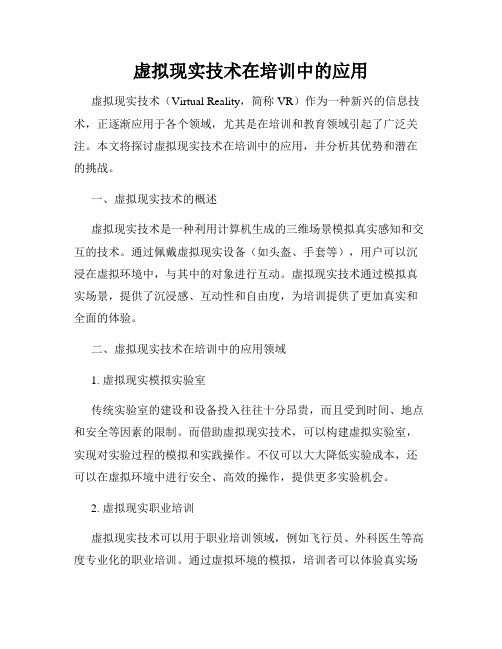
虚拟现实技术在培训中的应用虚拟现实技术(Virtual Reality,简称VR)作为一种新兴的信息技术,正逐渐应用于各个领域,尤其是在培训和教育领域引起了广泛关注。
本文将探讨虚拟现实技术在培训中的应用,并分析其优势和潜在的挑战。
一、虚拟现实技术的概述虚拟现实技术是一种利用计算机生成的三维场景模拟真实感知和交互的技术。
通过佩戴虚拟现实设备(如头盔、手套等),用户可以沉浸在虚拟环境中,与其中的对象进行互动。
虚拟现实技术通过模拟真实场景,提供了沉浸感、互动性和自由度,为培训提供了更加真实和全面的体验。
二、虚拟现实技术在培训中的应用领域1. 虚拟现实模拟实验室传统实验室的建设和设备投入往往十分昂贵,而且受到时间、地点和安全等因素的限制。
而借助虚拟现实技术,可以构建虚拟实验室,实现对实验过程的模拟和实践操作。
不仅可以大大降低实验成本,还可以在虚拟环境中进行安全、高效的操作,提供更多实验机会。
2. 虚拟现实职业培训虚拟现实技术可以用于职业培训领域,例如飞行员、外科医生等高度专业化的职业培训。
通过虚拟环境的模拟,培训者可以体验真实场景,并进行反复练习,以提高技能水平和应对各类复杂情况的能力。
虚拟现实技术还可以对培训者的操作进行实时监控和评估,提供个性化的学习反馈。
3. 虚拟现实团队合作虚拟现实技术可以打破时间和地域的限制,实现远程协作和团队培训。
通过佩戴虚拟现实设备,多个用户可以在虚拟环境中进行沟通和互动,共同解决问题、讨论方案。
这种虚拟现实的团队合作培训模式可以提升团队协作能力,培养领导力和问题解决能力。
三、虚拟现实技术应用的优势1. 沉浸感和真实感虚拟现实技术可以提供沉浸感和真实感,使培训者身临其境,感受真实的场景和情境。
这种亲身体验可以激发学习者的情感和兴趣,提高学习的积极性和主动性。
2. 安全和环保在某些危险环境下或对特定设备的操作,虚拟现实技术可以提供一个安全和环保的训练场景。
学习者可以在虚拟环境中进行反复练习,犯错不会带来实际损失,同时也减少了环境资源的消耗。
虚拟现实技术在企业培训中的应用案例分析

虚拟现实技术在企业培训中的应用案例分析随着科技的飞速发展,虚拟现实技术(Virtual Reality,简称VR)逐渐在企业培训领域展现巨大的潜力。
虚拟现实技术通过提供沉浸式的、真实感的培训环境,可以帮助企业提高培训效果,减少成本和风险。
本文将通过分析几个虚拟现实技术在企业培训中的成功应用案例,突显虚拟现实技术的优势和潜力。
一个显著的成功案例是虚拟现实在安全培训中的应用。
许多企业面临着高风险和危险的工作环境,如在石油和天然气、化工等行业中。
而常规的安全培训往往无法真实地模拟这些危险情境,并且存在一定的安全风险。
通过虚拟现实技术,员工可以在虚拟环境中进行危险操作的模拟,从而提高应对危险情况的能力,减少事故的发生。
例如,一些石油公司利用虚拟现实技术培训员工应对油井爆炸的紧急情况,通过虚拟现实技术的沉浸感,员工可以更加真实地体验爆炸现场,从而更好地掌握紧急情况的处理方法。
虚拟现实技术也可以应用于销售和客户服务培训。
在传统的销售和客户服务培训中,员工在面对客户提问和抱怨时,常常面临着尴尬和缺乏经验的情况。
通过虚拟现实技术,员工可以模拟真实的销售和客户服务场景,提前接触各种情况并进行反复训练。
虚拟现实技术可以帮助员工熟悉客户的需求和偏好,并教授他们如何进行有效的销售和服务。
例如,一些高端酒店利用虚拟现实技术培训前台员工,让他们模拟不同类型和要求的客户,从而提供更高质量的服务。
虚拟现实技术还可以应用于复杂技能培训。
复杂技能培训往往需要长时间的实践和指导,而且成本较高。
虚拟现实技术可以提供逼真的模拟环境,员工可以在没有真实风险的情况下进行反复训练,以提高技能的掌握程度。
例如,在医疗培训领域,虚拟现实技术可以帮助医生进行手术模拟和操作训练,而无需进行实际患者操作。
这样不仅降低了培训成本,还减少了潜在的风险。
虚拟现实技术也可以用于培养团队合作和沟通能力。
企业中的团队合作和沟通是取得成功的关键,而这些技能通常需要长时间的实践和培养。
虚拟现实在职业培训中的应用及其特点
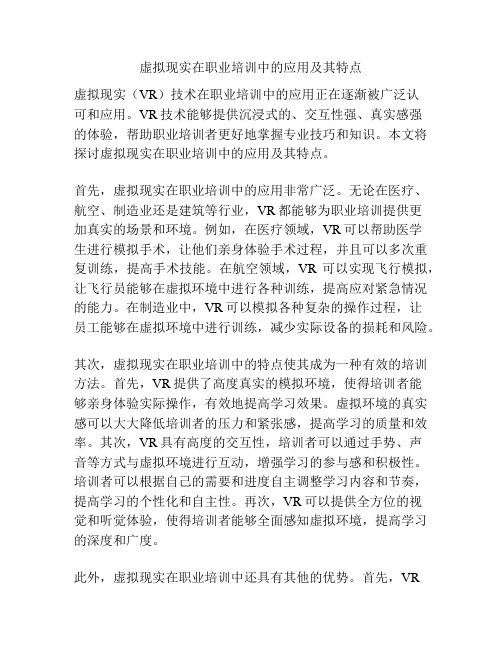
虚拟现实在职业培训中的应用及其特点虚拟现实(VR)技术在职业培训中的应用正在逐渐被广泛认可和应用。
VR技术能够提供沉浸式的、交互性强、真实感强的体验,帮助职业培训者更好地掌握专业技巧和知识。
本文将探讨虚拟现实在职业培训中的应用及其特点。
首先,虚拟现实在职业培训中的应用非常广泛。
无论在医疗、航空、制造业还是建筑等行业,VR都能够为职业培训提供更加真实的场景和环境。
例如,在医疗领域,VR可以帮助医学生进行模拟手术,让他们亲身体验手术过程,并且可以多次重复训练,提高手术技能。
在航空领域,VR可以实现飞行模拟,让飞行员能够在虚拟环境中进行各种训练,提高应对紧急情况的能力。
在制造业中,VR可以模拟各种复杂的操作过程,让员工能够在虚拟环境中进行训练,减少实际设备的损耗和风险。
其次,虚拟现实在职业培训中的特点使其成为一种有效的培训方法。
首先,VR提供了高度真实的模拟环境,使得培训者能够亲身体验实际操作,有效地提高学习效果。
虚拟环境的真实感可以大大降低培训者的压力和紧张感,提高学习的质量和效率。
其次,VR具有高度的交互性,培训者可以通过手势、声音等方式与虚拟环境进行互动,增强学习的参与感和积极性。
培训者可以根据自己的需要和进度自主调整学习内容和节奏,提高学习的个性化和自主性。
再次,VR可以提供全方位的视觉和听觉体验,使得培训者能够全面感知虚拟环境,提高学习的深度和广度。
此外,虚拟现实在职业培训中还具有其他的优势。
首先,VR技术可以跨越时间和空间的限制,使得培训者可以随时随地进行学习。
培训者可以通过佩戴VR头盔等设备,在家或者办公室就能够进行培训,不再受到时间和地点的限制。
其次,虚拟现实还可以降低培训的成本。
通过利用虚拟环境进行培训,能够减少实际场景的搭建和设备的购买。
特别是对于一些高成本、高风险的培训项目,如医疗手术和航空培训,使用虚拟现实可以显著降低培训的成本和风险。
然而,虚拟现实在职业培训中也面临一些挑战。
虚拟现实技术在教育培训中的应用案例分享
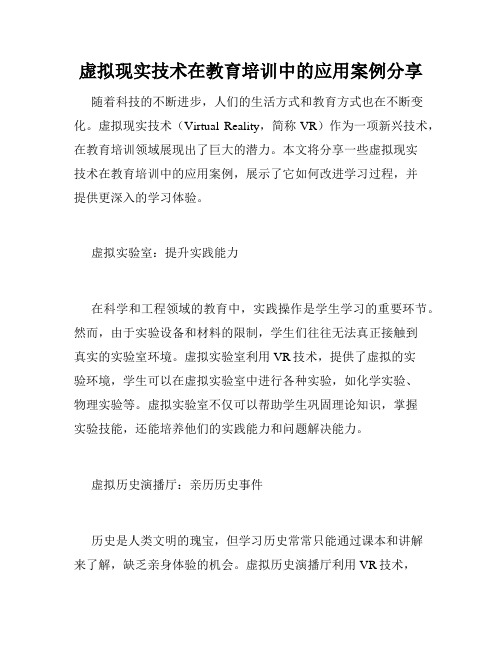
虚拟现实技术在教育培训中的应用案例分享随着科技的不断进步,人们的生活方式和教育方式也在不断变化。
虚拟现实技术(Virtual Reality,简称VR)作为一项新兴技术,在教育培训领域展现出了巨大的潜力。
本文将分享一些虚拟现实技术在教育培训中的应用案例,展示了它如何改进学习过程,并提供更深入的学习体验。
虚拟实验室:提升实践能力在科学和工程领域的教育中,实践操作是学生学习的重要环节。
然而,由于实验设备和材料的限制,学生们往往无法真正接触到真实的实验室环境。
虚拟实验室利用VR技术,提供了虚拟的实验环境,学生可以在虚拟实验室中进行各种实验,如化学实验、物理实验等。
虚拟实验室不仅可以帮助学生巩固理论知识,掌握实验技能,还能培养他们的实践能力和问题解决能力。
虚拟历史演播厅:亲历历史事件历史是人类文明的瑰宝,但学习历史常常只能通过课本和讲解来了解,缺乏亲身体验的机会。
虚拟历史演播厅利用VR技术,通过重现历史事件的场景和人物,使学生能够身临其境地亲历历史。
比如,学生可以通过虚拟现实技术,在VR演播厅中亲眼目睹决策者在历史转折点上做出的决策,并亲身感受历史事件的真实情景。
这样的学习体验不仅可以激发学生们的兴趣,还能帮助他们更好地理解历史和培养批判性思维能力。
虚拟语言学堂:增强语言交流能力语言学习是一项需要大量练习和实践的任务。
传统的语言学习方式可能会限制学生们的语言交流能力。
虚拟语言学堂结合VR 技术,提供了一个虚拟的语言交流环境。
学生可以通过VR头戴设备进入虚拟的语言课堂,与虚拟的老师和其他学生进行交流练习。
这样的学习环境可以帮助学生更好地掌握语言技能,并提高他们的语言交流能力。
同时,虚拟语言学堂还可以提供多样化的场景和角色扮演,使学生们能够在真实情景中进行语言练习。
虚拟手术室:培训医学专业技能在医学教育中,临床培训往往需要大量的时间和资源,并且对患者的安全带来一定的风险。
虚拟手术室利用VR技术,提供了一个安全、可控的仿真手术环境。
虚拟现实技术在教育培训中的应用前景如何
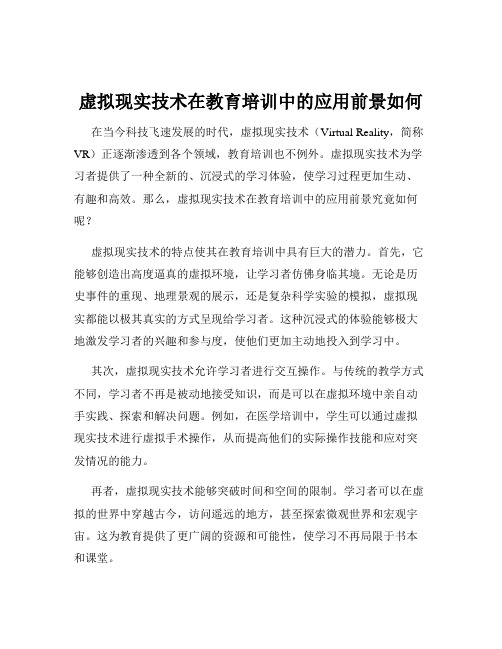
虚拟现实技术在教育培训中的应用前景如何在当今科技飞速发展的时代,虚拟现实技术(Virtual Reality,简称VR)正逐渐渗透到各个领域,教育培训也不例外。
虚拟现实技术为学习者提供了一种全新的、沉浸式的学习体验,使学习过程更加生动、有趣和高效。
那么,虚拟现实技术在教育培训中的应用前景究竟如何呢?虚拟现实技术的特点使其在教育培训中具有巨大的潜力。
首先,它能够创造出高度逼真的虚拟环境,让学习者仿佛身临其境。
无论是历史事件的重现、地理景观的展示,还是复杂科学实验的模拟,虚拟现实都能以极其真实的方式呈现给学习者。
这种沉浸式的体验能够极大地激发学习者的兴趣和参与度,使他们更加主动地投入到学习中。
其次,虚拟现实技术允许学习者进行交互操作。
与传统的教学方式不同,学习者不再是被动地接受知识,而是可以在虚拟环境中亲自动手实践、探索和解决问题。
例如,在医学培训中,学生可以通过虚拟现实技术进行虚拟手术操作,从而提高他们的实际操作技能和应对突发情况的能力。
再者,虚拟现实技术能够突破时间和空间的限制。
学习者可以在虚拟的世界中穿越古今,访问遥远的地方,甚至探索微观世界和宏观宇宙。
这为教育提供了更广阔的资源和可能性,使学习不再局限于书本和课堂。
在教育领域,虚拟现实技术已经在多个学科中得到了应用。
在科学教育中,学生可以通过虚拟现实技术观察到原子和分子的结构,直观地理解抽象的科学概念。
在历史教育中,学习者可以“亲身经历”历史事件,感受不同时代的社会风貌和文化氛围。
在语言学习中,虚拟现实技术可以创造出逼真的语言环境,让学习者与虚拟的人物进行交流,提高语言运用能力。
在培训方面,虚拟现实技术为职业培训带来了显著的变革。
例如,飞行员可以在虚拟的驾驶舱中进行模拟飞行训练,消防员可以在虚拟的火灾场景中进行灭火演练。
这种模拟训练不仅降低了培训成本,还减少了实际操作中的风险。
然而,虚拟现实技术在教育培训中的应用也面临一些挑战。
首先是技术成本问题。
VR技术在职业技能培训中的应用案例分享

VR技术在职业技能培训中的应用案例分享近年来,虚拟现实(VR)技术在各个领域得到了广泛的应用和推广,其中之一就是在职业技能培训中的应用。
通过虚拟现实技术,人们可以身临其境地体验各种职业场景,提高自身的技能水平。
本文将分享几个VR技术在职业技能培训中的应用案例。
一、医疗领域在医疗领域,VR技术被广泛应用于医学生的实践训练中。
传统的医学教育主要依靠实习和观察,但这种方式存在一定的局限性,比如手术操作时的压力和风险。
通过VR技术,医学生可以在虚拟环境中进行手术模拟,熟悉手术步骤和操作技巧,提高手术的准确性和安全性。
此外,VR技术还可以用于模拟各种疾病的诊断和治疗,帮助医学生更好地理解和应对不同的病例。
二、建筑设计在建筑设计领域,VR技术可以帮助建筑师和设计师更好地预览和调整设计方案。
传统的设计过程中,建筑师通常依靠平面图和模型来进行设计,但这种方式难以真实地展示建筑的效果和空间感。
通过VR技术,建筑师可以在虚拟环境中漫游建筑,感受不同的空间和材质,从而更好地调整设计方案。
此外,VR技术还可以用于建筑施工的培训,通过模拟各种施工场景和操作步骤,提高施工人员的技能水平和安全意识。
三、航空领域在航空领域,VR技术被广泛应用于飞行员的培训和模拟训练中。
传统的飞行员培训主要依靠实际驾驶飞机,但这种方式成本高昂且存在风险。
通过VR技术,飞行员可以在虚拟环境中进行飞行模拟,体验各种飞行场景和紧急情况,提高应对突发事件的能力和反应速度。
此外,VR技术还可以用于航空机械维修的培训,通过模拟各种故障和维修操作,提高维修人员的技能水平和工作效率。
四、教育领域在教育领域,VR技术可以提供更加生动和互动的学习体验。
传统的教学方式主要依靠课堂教学和教科书,但这种方式难以激发学生的兴趣和动力。
通过VR技术,学生可以身临其境地参与各种学习活动,比如参观历史遗址、探索自然奇观等,提高学生的学习积极性和主动性。
此外,VR技术还可以用于语言学习和技能培训,通过模拟各种语境和场景,提高学生的语言交流能力和实践操作技能。
虚拟现实技术在职业培训中的应用
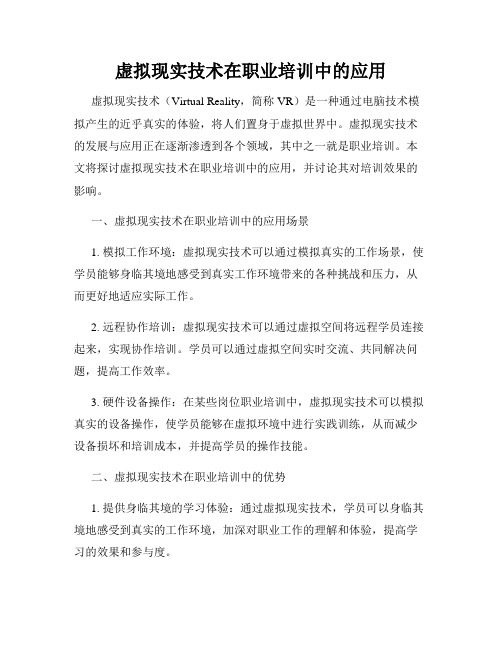
虚拟现实技术在职业培训中的应用虚拟现实技术(Virtual Reality,简称VR)是一种通过电脑技术模拟产生的近乎真实的体验,将人们置身于虚拟世界中。
虚拟现实技术的发展与应用正在逐渐渗透到各个领域,其中之一就是职业培训。
本文将探讨虚拟现实技术在职业培训中的应用,并讨论其对培训效果的影响。
一、虚拟现实技术在职业培训中的应用场景1. 模拟工作环境:虚拟现实技术可以通过模拟真实的工作场景,使学员能够身临其境地感受到真实工作环境带来的各种挑战和压力,从而更好地适应实际工作。
2. 远程协作培训:虚拟现实技术可以通过虚拟空间将远程学员连接起来,实现协作培训。
学员可以通过虚拟空间实时交流、共同解决问题,提高工作效率。
3. 硬件设备操作:在某些岗位职业培训中,虚拟现实技术可以模拟真实的设备操作,使学员能够在虚拟环境中进行实践训练,从而减少设备损坏和培训成本,并提高学员的操作技能。
二、虚拟现实技术在职业培训中的优势1. 提供身临其境的学习体验:通过虚拟现实技术,学员可以身临其境地感受到真实的工作环境,加深对职业工作的理解和体验,提高学习的效果和参与度。
2. 安全环境下的实践训练:虚拟现实技术能够提供一个安全的训练环境,让学员在虚拟世界中进行操作和实践,避免了实际工作环境可能带来的风险和危险。
3. 自主学习和反馈机制:虚拟现实技术在培训中可以提供自主学习和反馈机制,学员通过自主探索和实践,可以根据自身情况对学习进程进行调整,并通过虚拟世界的反馈机制及时纠正错误。
三、虚拟现实技术在职业培训中的挑战1. 技术成本较高:虚拟现实技术的成本相对较高,包括硬件设备的购买和维护、软件开发和定制等。
这对于一些资源匮乏的机构来说可能是一个难以承担的负担。
2. 内容和应用的匹配度:虚拟现实技术的应用需要与职业培训的实际需求相匹配,否则可能会导致培训效果不佳。
需要投入大量资源进行虚拟环境和场景的开发,确保与培训目标相契合。
3. 技术更新和维护:虚拟现实技术的更新速度很快,需要不断进行升级和维护。
- 1、下载文档前请自行甄别文档内容的完整性,平台不提供额外的编辑、内容补充、找答案等附加服务。
- 2、"仅部分预览"的文档,不可在线预览部分如存在完整性等问题,可反馈申请退款(可完整预览的文档不适用该条件!)。
- 3、如文档侵犯您的权益,请联系客服反馈,我们会尽快为您处理(人工客服工作时间:9:00-18:30)。
(工作)培训中的VR(虚拟现实)应用By Patrick KingslandLloyd’s Register has developed a Virtual Reality (VR) Safety Simulator to help support training and knowledge transfer in the energy industry and illustrate the need for a continued focus on safety and risk assessment. Patrick Kingsland spoke to LR’s VP of Marketing and Communications, Peter Richards and Global Academy Training Manager, Luis De La Fuente, about how it works.劳埃德船级社刚刚生产了一款VR安全模拟器来帮助能源工业的人才培训以及知识传送并且来例证在安全和风险评估方面的持续的关注点的需要,Patrick Kingsland对LR的市场与协商部的副总裁Peter Richards,全球学院的培训经理Luis De La Fuente进行了采访,来调查这个机器是怎样进行工作的Patrick Kingsland: What are the key challenges the offshore industry faces today in terms of safety training?PK:现在海洋工程在安全性能培训方面存在的主要挑战有哪些呢?Luis De La Fuente: The oil and gas industry is very cyclical. During downturns you have skilled people leaving and companies can be left with a knowledge gap with only a handful of experienced people. Challenging times often result in less training as training budgets get reduced or are transferred elsewhere. During boom periods you often get a sudden influx of new talent who are often less experienced. And some of the more skilled personnel who were let go during the downturn leave the industry and decide not to come back. This means you lose quite a bit of hands-on knowledge and experience. For us, the whole goal is to work out how to reduce that learning gap, and get a person to a competent, senior level in as short amount of time as possible.Luis De La Fuente:油气行业发展具有明显的周期性,当产业处于低迷期时,经验丰富的员工离开了,之后公司可能面临着只有几个有经验员工的困境,即出现了知识鸿沟,艰难的时期由于培训经费的下降或挪用将会导致更少的(知识技能)培训。
在行业的黄金时期,公司常常会有一批知识丰富但是缺乏经验的员工的涌入,并且那些在行业低迷期弃你而去的部分有经验的员工将会决定离开这个行业并且不再回来。
这就意味着你的公司失去了一大批实打实的知识和经验储备。
对于我们来说,我们的整体目标是弄明白怎样减小知识鸿沟,并且在尽可能短的时间里培养出有足够能力的能力更上一层的员工。
PK: How could virtual reality help reduce that learning gap in your opinion?PK:就您来看,VR技术怎样帮助(公司)减小知识鸿沟呢?LF: Well one good way is to introduce as much theory as possible so that when staff get onto the job sites they are familiar with what they are doing. But you still have a gap there between theory and practice. With VR we can bring some of that hands-on practical experience into the classroom without necessarily having to put guys out there where it’s more dangerous.LF:嗯,一个好的方法是介绍尽可能多的理论(给员工),这样当职员步入工作岗位,他们会更加熟悉自己在做什么,但是在理论与实践当中仍然存在知识鸿沟,使用VR设备,我们可以把我们的一些实打实的实践性经验带入教室而不用必须让那些新手进入更加危险的地方(去学习)Peter Richards:It’s about making the training environment more immersive so that you can really start to understand the potential hazards you are going to be exposed to. VR also provokes a reaction from individuals on the implication their actions will have in an offsho re environment. And because it’s interactive people are coming away from our VR experience and actually talking about safety training in a positive way. Bear in mind this is not a subject that generally generates that level of enthusiasm.Peter Richards:VR设备让培训环境更加庞大,这样你可以真正开始理解你将要面临的潜在危险。
VR也能引起人们的反应,让他们产生自己的行为将在一个海上施工环境当中进行。
并且因为那些参与过VR培训的人将要远离自己的VR经验(并转化为实际经验),然后真正能肯定地说出安全培训的具体内容。
(他们就会)将这项工作并不是逐渐使人产生激情(这一事实)牢记在心。
PK: How has VR technology improved over the past few years and where did you look for inspiration?PK:VR技术在过去这几年里是怎样发展的?你们是怎样找寻灵感的?PR:I think we’re now at a stage where VR is at a tipping point. The technology has got a lot better and the cost has come down. It’s more viable to look at it as a realistic mainstream application as opposed to where I think we were four years ago when everybody was talking about virtual reality but it was really just an overgrown 3D video.During this gestation period we were closely following the technology to see how it was developing. In conjunction with a number of agencies we looked at gaming technology in particular. The hardware we are now using deploys handsets as well as head-sets. This gives us the ability to interact more with the environment as opposed to the initial development of VR which was just a headset.PR:我认为我们现在处于一个VR技术高速发展的阶段,这项技术已经变得更好而且它的成本也在下降。
相较于四年前当所有人在讨论的虚拟现实技术仅仅是一个过头的3D电影技术的时候,我对我们未来出路的设想而言,现在将(VR技术)视作当下的主流期许是更具有可行性的。
在构想时期当中,我们一直紧紧跟进这项技术的进展来观察它是怎样发展的,在与许多机构的协力下我们尤其关注游戏技术。
现在我们使用的硬件设备主要施用于手柄以及头部设备。
相对于最初的VR技术发展只有耳机来说,这些提供给我们了更好地与环境实现交互体验的能力PK: What kind of offshore scenarios could VR training be used for?PK:VR培训能用于哪些海洋工程的场景呢?PR: When developing the scenarios, we wanted to illustrate to individuals that a wrong decision could result in fatality. Obviously we didn’t want to glorify the actualincidents taken from real-life scenarios so we used interactive crash test dummies to visually identify with the different settings.One of the main scenarios we have is a lifting situation. There is a motor, which is lifted onto a crane and a lifting bolt which is calibrate d to the wrong weight. You are able to look at all the variables before the actual lift takes place. Then the scenario happens. The crash test dummy is on a platform, the motor is lifted, the dummy stands underneath the motor and the bolt shears from the motor and then lands on the dummy.PR:当开发这些场景的时候,我们想告知员工们一个错误的决定可以导致严重的事故,显然,我们并不想美化从现实生活中的意外中选取的场景,所以我们采用了搭载交互传感式设备的撞击实验用假人来从视觉上区分不同的设定。
